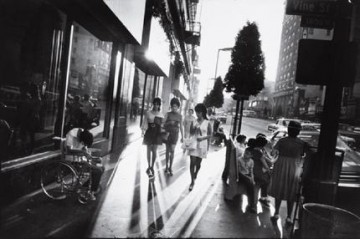Originally published in the Marina Times San Francisco in March 2013
“I like to think of photographing as a two-way act of respect. Respect for the medium, by letting it do what it does best, describe. And respect for the subject, by describing as it is. A photograph must be responsible to both.” –Garry Winogrand
Through June 2, 2013, the SF MOMA will feature the first major touring exhibition and catalogue in 25 years dedicated to the work of Garry Winogrand. A street photographer from the Bronx, Winogrand became best known for his documentary-style depiction of American life in the 1960’s.
While working as a commercial photographer and a teacher, Winogrand wandered the streets of New York City with his 35mm Leica rapidly taking photographs of the people in his immediate vicinity. Though he shot several rolls of film a day, he didn’t shoot from the hip. Winogrand’s methodology only appeared fast and loose, when in fact he always took meticulous care to frame his composition through his viewfinder, utilizing his pre-focused wide-angle lens to aid him in the swift capturing of images.
Winogrand’s process of developing film was conversely unhurried. He often let a roll of film sit for years before taking it to the darkroom so he could adequately detach himself from personal memories associated with the moments the photos were taken. The distance created a greater objectivity, and he felt the resulting photographs could be evaluated with a critical eye unspoiled by the emotions affiliated with that instant.
Other photographers influenced the work of Garry Winogrand, and he encouraged his students to look at great photographs. Weegee, Henri Cartier-Bresson, Paul Strand, Walker Evans and Brassai were among the artists who affected his work primarily because he could learn from them.
Yet for Winogrand, by all appearances, watching meant far less than doing. He died at the age of 56 leaving behind 2,500 rolls of undeveloped film. It is estimated that at the time of his death, Winogrand had taken over five million photos and never saw a half million of his own shots. As an artist, he was prolific so that he could be intentional; fleeting so he could be deliberate in selecting the form and content that would define his body of work.
SF MOMA’s curatorial research undertaken for this exhibit allows the public to see, for the first time, the expansive breadth of Garry Winogrand’s photos of post World War II American life in all its enthusiasm and apprehension.